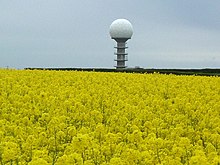Lincolnshire Wolds
The Lincolnshire Wolds are a range of hills in the English county of Lincolnshire . They are the highest area in eastern England between Yorkshire and Kent . The range of hills runs parallel to the North Sea from the Humber River in the northwest to the small town of Spilsby in the southeast.
geography
The hills in the Lincolnshire Wolds are made of chalky limestone and sandstone that was deposited during the Cretaceous Period . Characteristic are the numerous deeply carved valleys that were created during the Worm Ice Age by the movement of the ice. The slopes of the valleys are usually steep, while the valley floor is flat.
Geologically speaking, the Lincolnshire Wolds are a continuation of the more northerly Yorkshire Wolds in the East Riding of Yorkshire . The two hills that were once connected are separated by the River Humber , whose forces of erosion have flattened the landscape in between.
The highest point of the Wolds and of all of Lincolnshire is on the hill Wolds Top at Normanby-le-Wold at an altitude of 168 m , marked by a trigonometric point . The hills offer good views over the Fens and Salt Marshes in the rest of Lincolnshire, the Belmont transmission tower , the Humber Bridge and Lincoln Cathedral .
The wolds are sparsely populated and have a decidedly rural character. Many field names originally come from the Vikings . There are also numerous desert areas - former villages that were abandoned in the Middle Ages due to erosion and epidemics. The area is surrounded by a few small towns such as Alford , Horncastle , Louth , Market Rasen , Caistor and Spilsby .
Landscape protection
In 1973 the Lincolnshire Wolds were recognized as the Area of Outstanding Natural Beauty (AONB). They are therefore subject to special planning regulations that primarily affect landscape management. The AONB is 560 km² and includes areas in the districts of East Lindsey , West Lindsey and North East Lincolnshire . The boundaries of the AONB are marked by signs on the access roads.
tourism
The wolds are marketed as a destination for tourists . It particularly highlights the fact that the writer Alfred Tennyson was born in the village of Somersby. The local farmers are encouraged to diversify into tourism. The Wolds are known as an area for hiking ; the Viking Way , a long distance footpath, runs from Barton-upon-Humber to Rutland . The roads in the hills are extremely popular with motorcyclists . At Louth is Cadwell Park , one of the most famous motor racing circuits in the country.
Others
The Lincoln sheep , one of the ten traditional long-wool sheep breeds in Great Britain , originated in the Wolds . The Lincoln sheep is the largest breed of British domestic sheep and was specially bred for its heavy, long-stapled and shiny fleece. The temporarily great prosperity of Lincolnshire can be traced back to these sheep among other things.
Web links
Single receipts
- ↑ Wolds is a term used in England about to describe a landscape consisting of hills and open country on a base of limestone or chalk is
- ^ Philip Walling: Counting Sheep - A Celebration of the Pastoral Heritage of Britain . Profile Books, London 2014, ISBN 978-1-84765-803-6 . P. 22.
Coordinates: 53 ° 21 ′ N , 0 ° 6 ′ W



